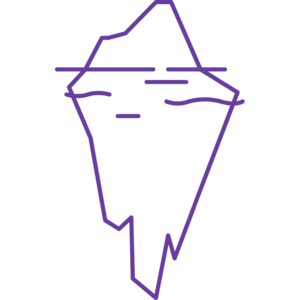Systems Thinking: The Iceberg Model

Systems thinking is a way of approaching problems that asks how various elements within a system — which could be an ecosystem, an organization, or something more dispersed such as a supply chain — influence one another. Rather than reacting to individual problems that arise, a systems thinker will ask about relationships to other activities within the system, look for patterns over time, and seek root causes.
Goal
Explore a system thinking approach and improve problem solving skills.
Materials
Instructions
Step 1:
Introduction
One systems thinking model that is helpful for understanding both global and local issues is the iceberg model.
We know that an iceberg has only 10 percent of its total mass above the water while 90 percent is underwater. But that 90 percent is what the ocean currents act on, and what creates the iceberg’s behavior at its tip. Global and local issues can be viewed in this same way.
LEVELS OF THINKING
1. The Event Level The event level is the level at which we typically perceive the world—for instance, waking up one morning to find we have caught a cold. While problems observed at the event level can often be addressed with a simple readjustment, the iceberg model pushes us not to assume that every issue can be solved by simply treating the symptom or adjusting at the event level.
2. The Pattern Level If we look just below the event level, we often notice patterns. Similar events have been taking place over time — we may have been catching more colds when we haven’t been resting enough. Observing patterns allows us to forecast and forestall events.
3. The Structure Level Below the pattern level lies the structure level. When we ask, “What is causing the pattern we are observing?” The answer is usually some kind of structure. Increased stress at work due to the new promotion policy, the habit of eating poorly when under stress, or the inconvenient location of healthy food sources could all be structures at play in our catching a cold. According to Professor John Gerber, structures can include the following:
- Physical things — like vending machines, roads, traffic lights or terrain.
- Organizations — like corporations, governments, and schools.
- Policies — like laws, regulations, and tax structures.
- Ritual — habitual behaviors so ingrained that they are not conscious.
4. The Mental Model Level Mental models are the attitudes, beliefs, morals, expectations, and values that allow structures to continue functioning as they are. These are the beliefs that we often learn subconsciously from our society or family and are likely unaware of. Mental models that could be involved in us catching a cold could include: a belief that career is deeply important to our identity, that healthy food is too expensive, or that rest is for the unmotivated.
Step 2:
PUTTING THE LEVELS TOGETHER
Take a look at the diagram attached to see the Iceberg Model applied to an instance of catching a cold.
GIVE IT A TRY!
Select a recent event that strikes you as urgent, important or interesting. Some examples include a recent weather event, the pandemic, a controversial court decision or a high profile court case; a local policy change or contentious issue; recent military action between nations; or an issue you’ve personally encountered recently.
Write the event (what is observable about the event) at the top of the iceberg (you might draw an iceberg/triangle) and work your way down through the patterns, underlying systems and mental models, adding as many as you can think of.
It can also be useful to move up and down between levels as you think more about the event.
Step 3:
QUESTIONS TO CONSIDER AFTER TRYING OUT THE ICEBERG MODEL
Does the iceberg model help broaden your perspective? If so, how might this new perspective be helpful?
Consider the concept of entry, or “leverage” points. These are points at which to intervene in a system that could lead to systemic transformation.
Does the exercise show you any new entry points at which you are inspired to intervene?
What issues that have frustrated you might be interesting to analyze with the Iceberg Model?
What else?
ACTION STEPS Is there action to take? Consider the Who/What/When Matrix to connect people with clear actions on tasks and a commitment on when they will complete the task.
Attachments
- Iceberg-Model.width-800.png
- systems-thinking-iceberg-cover.png
Background
The Iceberg Model + core exercise are attributed to Ecochallenge https://ecochallenge.org/iceberg-model
Source: Hyper Island toolbox
Hyper Island designs learning experiences that challenge companies and individuals to grow and stay competitive in an increasingly digitized world. With clients such as Google, Adidas and IKEA, Hyper Island has been listed by CNN as one of the most innovative schools in the world.
Author
Hyper Island designs transformative learning experiences to enable growth – for individuals and for businesses. Unlike typical education or service providers, we follow a tried-and-tested methodology and a wide network of real industry experts. Through our global network of schools and business services, we put people at the heart of innovation, leadership and change – for success today and tomorrow.